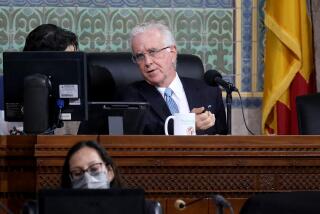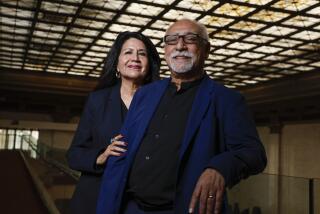Arts Commission Adopts Funding Evaluation Plan
SAN DIEGO — A funding evaluation plan that emphasizes administrative skill, fund raising and audience size above artistic quality was unanimously approved Friday by the San Diego Commission for Arts and Culture.
The proposal, which still must be approved by the City Council, contains a four-point ranking system and requires that applications be evaluated objectively by special panels. The new process, in which commission members make up a majority of each evaluation panel, is modeled after one used by the state of Texas.
Arts officials who attended the meeting generally praised the proposal.
“It looks really good on the whole,” said Ethan Feerst, executive director of the Sledgehammer Theatre troupe. Feerst had reservations, however, about some aspects of the allocation process.
“The lack of a peer review . . . and having a majority of the (Arts) Commission on the panels is problematic,” he said.
Old Globe Theatre acting development director Christopher Redo called the evaluation plan “another good step in bringing equanimity and parity to funding the arts in San Diego.” Redo said the process voted on Friday was “not perfect” but could be modified. He labeled it “another encouraging development that the city of San Diego is looking at the arts and the cultural community.”
The process that the commission adopted provides specific criteria for evaluating cultural institutions in a set of guidelines that include administrative excellence, “evidence of community representation and support” and need.
Applications will be considered in three categories, or “levels,” based on the size of the institution, and a fourth “special projects” category.
In applying for city funds, larger institutions must also demonstrate “ability to develop San Diego as a cultural destination”--that is, a way to get tourists here.
Commission Chairman Milton Fredman said the panels will not review artistic quality. “They will review the quality of the organization, not the quality of the artistic program,” he said.
Commission member Carol Caplan declared that audience size and fund-raising success are, to a degree, measures of artistic excellence and that the reviewing panels may wish to consider national and state grants as indicators of artistic excellence in their ranking.
“We’re not a small California Arts Council,” Caplan said. “Our role is to support what we have. Who is qualified to do a peer review of the San Diego Symphony? There’s only one” source of peers--the symphony.
Arts groups, until last year, applied for city funds either through COMBO or went directly to the city manager or the City Council. In 1987, the Combined Arts and Educational Council announced that it would no longer serve as a funding conduit for the city, and a task force recommended the formation of a commission to centralize recommendations on arts funding.
In 1988, an ad hoc panel made up of former arts task force members, city finance officials and arts administrators reviewed applications for almost $5 million in city grants.
The Commission for Arts and Culture, established in February, 1988, will review all applications for city funds.
Arts groups must submit a letter of intent, including dollar amount requested, to the commission offices at the city’s Executive Complex, 1010 2nd Ave., by Feb. 1. Application forms will be available Feb. 17, and the deadline for submission is March 17.
More to Read
The biggest entertainment stories
Get our big stories about Hollywood, film, television, music, arts, culture and more right in your inbox as soon as they publish.
You may occasionally receive promotional content from the Los Angeles Times.










